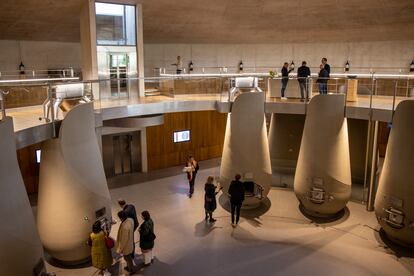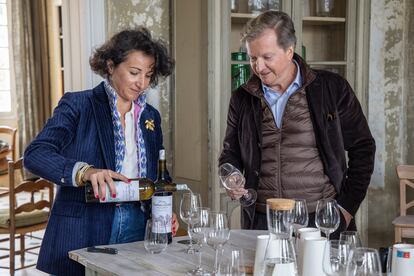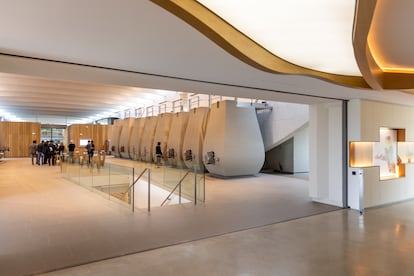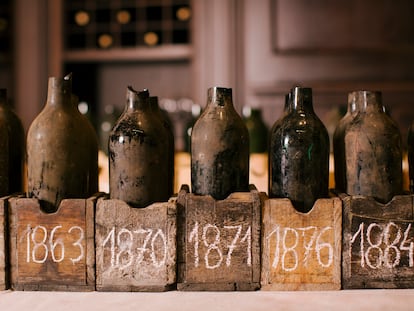Bordeaux knows how to sell wine: it does so two years before it is ready for consumers
Winemakers open their doors for buyers to taste and purchase their products in a popular and thriving futures market

It’s the biggest week for wine in Bordeaux, one of the world’s most renowned wine-producing regions. The Semaine des Primeurs on April 24-27 attracted buyers from around the globe in search of the best en primeur wines — a method of purchasing wine early while it’s still in the barrel. Organized by the association of Bordeaux vintners (UGCB), this annual event is a unique system for selling wine that other wine-producing regions are now emulating.
The origins of selling wine futures in Bordeaux can be traced to the early 17th century and Dutch and British influences. But the practice gathered steam as World War II broke out and the famed Bordeaux winemakers began offering their product early to recoup investments and secure sales during precarious times. The practice also helped preserve the many stately châteaux that house wineries in the seven most famous areas of Bordeaux: Médoc, Graves, Sauternes, Saint Emilion, Pomerol, Pessac-Léognan, Entre-deux Mers and Fronsac. The financial crisis of the 1970s later led Baron Philippe de Rothschild to open his château for the first time so buyers could taste his immature wines and gauge their future potential.
Rothchild’s idea gradually caught on with other Bordeaux vintners, and the selling of wine futures was institutionalized in 1982. Once a year, wineries open their doors for distributors, buyers and the media to evaluate their wares. The UCCG reported that 7,000 people attended this year’s event, which included group tastings in spaces shared by multiple producers. In the Château de Fieuzal’s vat room, a large group of winemakers offered their products to crowds of buyers who went from stand to stand with glasses in hand to taste wines that will be available to consumers in two years.

Veteran winemaker Paulin Calvet, owner of the century-old Château Picque Caillou and a host of the annual event, told EL PAÍS it “provides a lot of visibility and helps us connect with customers. A winery cannot attract so many people from all over the world on its own… Those who don’t take part lose the opportunity to sell their wines and position their wineries in the marketplace.”
Most Bordeaux wine sales — at least 80% — come from these early tastings of wine still in the barrel. The other 20% is sold once it’s bottled. Everybody wins because wine futures can be up to 50% cheaper (depending on the quality of the vintage) than when the mature product is released to the market. For example, a bottle of a Picque Caillou wine costs $25-30, according to Calvet, while the same wine en primeur costs $12-$15. “The price is ultimately determined by the quality of the vintage, but also by the winery’s reputation. Wine always increases in value — as demand increases, so does the price,” said Calvet. The retail price of the wine is up to the buyer. Advance sales provide a predictable flow of income for wineries, just as they do for Spanish ham producers who sell pork on the hoof and then cure their products for months or longer before it’s available to consumers.
The annual wine tasting event is more about socializing, testing and evaluating — the business deals happen afterward. “We come here to taste and enjoy. The buying and selling is done later, when the wineries decide how much wine they will put on the market and set the price. That’s when everyone can see the impact of the tasting event,” said François Lurton, who belongs to the fourth generation of a family that has been making wine in Bordeaux since 1897 and has wineries in Argentina, Chile, Australia, Portugal and Spain. Lurton invited us to some of the most exclusive tastings in the Bordeaux region, including one at Château Couhins Lurton (Pessac-Léognan), one of six wineries in magnificent mansions owned by his family with almost 1,500 acres (600 hectares) of vineyards and 200 employees that earn $22 million (€20 million) a year.

It’s a special time, says Mathilde Bazin de Caix-Lurton, CEO of Vignobles André Lurton, because “80% of our sales are made this week, and that’s significant.” But she shared a concern that haunts every winemaker — climate change. “We are diversifying our grapes and are replanting hardy varieties like malbec and carmenere. These were some of the original Bordeaux grapes, and we think we can grow them again since climate change has caused crop losses of 35%-40% every year. We could eventually lose entire harvests.”
It’s another reason many Bordeaux winemakers are collaborating in these events. “It’s very appealing for everyone, especially for less-known wines. But some of the big groups that are a bit snobbish don’t take part in the UCCG tasting. I think the impact is bigger if everyone participates,” said Lurton, who was surprised by the reluctance of Spanish winemakers to work together. “They don’t help each other — they’re all competitors. Here in France, we have proved that there is strength in unity. A winemaker who plays alone is weaker around the world.” Lurton praised the work of Grandes Pagos de España (GPE), an association of Spanish wine producers he would like to join.
Buying en primeur wine guarantees a supply that is steadily decreasing amid a growing global marketplace because of climate change. “We have less and less wine. In the 1980s, we produced 65 hectoliters [100 liters] per hectare, and now we produce between 40 and 45 hectoliters per hectare. Grape yields will continue to fall because of climate change.” With lower production comes higher demand, which some wineries are exploiting by making consumers covet their products. Prices go up and customers don’t mind waiting two years until the bottles are ready. “It’s just like a Hermès handbag — you have to wait six months or more to get one,” said Lurton.

Juan Manuel García is a Guatemalan who has lived in Spain for 23 years and owns the Carbonera group of restaurants (Santa Hamburguesa, Taberna Carbonera and La Tabernita). We met him and his son in the beautiful village of Saint Émilion after he attended his first Semaine des Primeurs in Bordeaux — two intense days in which they visited three wineries and many tastings. “The experience has been incredible — now we understand why people come here. It’s very well organized. We like to learn from the French, and we came here to buy because it’s cheaper for us.” García says it’s also a way of ensuring supply since there is an increasing shortage of wine and champagne. He has already marked next year’s event on his calendar and plans to make it an annual tradition with his son.
Javier Murúa is a vintner with Muriel Wines, a group based in Elciego (Álava province, northern Spain). For years, he has come to France to spy and buy. “I like this system because it generates interest in wine investment and the wine always increases in value,” said the winemaker, who is also an importer. “In the [Spanish] market, few people keep wine reserves. I like to buy and store it,” said Murúa, who visited over 25 wineries in two and a half days. If he gets it right, says Murúa, he can buy wine cheaply depending on how the vintage turns out. “But I always expect to make money from investing [in wine],” he said.
The asking price for the wine future is critical because it sparks interest around the world. May 4, at 9:30 a.m., was the date set by winemaker Jean Marc Dulong to announce the price of his en primeur wines. He quoted prices in euros, Hong Kong dollars, U.S. dollars and Swiss francs. He knows from experience that it’s a good time to buy wine. “You can buy at the best price, there’s a lot of demand and in two years the price goes up,” he said.
But the most important thing, said Thierry Capdemourlin, owner of Chàteau Balestard La Tonnelle in Saint Émilion, is for buyers “to guarantee their supply of wine, since we have less of it every year.”
Sign up for our weekly newsletter to get more English-language news coverage from EL PAÍS USA Edition
Tu suscripción se está usando en otro dispositivo
¿Quieres añadir otro usuario a tu suscripción?
Si continúas leyendo en este dispositivo, no se podrá leer en el otro.
FlechaTu suscripción se está usando en otro dispositivo y solo puedes acceder a EL PAÍS desde un dispositivo a la vez.
Si quieres compartir tu cuenta, cambia tu suscripción a la modalidad Premium, así podrás añadir otro usuario. Cada uno accederá con su propia cuenta de email, lo que os permitirá personalizar vuestra experiencia en EL PAÍS.
¿Tienes una suscripción de empresa? Accede aquí para contratar más cuentas.
En el caso de no saber quién está usando tu cuenta, te recomendamos cambiar tu contraseña aquí.
Si decides continuar compartiendo tu cuenta, este mensaje se mostrará en tu dispositivo y en el de la otra persona que está usando tu cuenta de forma indefinida, afectando a tu experiencia de lectura. Puedes consultar aquí los términos y condiciones de la suscripción digital.
More information
Últimas noticias
Most viewed
- Reinhard Genzel, Nobel laureate in physics: ‘One-minute videos will never give you the truth’
- Oona Chaplin: ‘I told James Cameron that I was living in a treehouse and starting a permaculture project with a friend’
- Pablo Escobar’s hippos: A serious environmental problem, 40 years on
- Chevy Chase, the beloved comedian who was a monster off camera: ‘Not everyone hated him, just the people who’ve worked with him’
- Why we lost the habit of sleeping in two segments and how that changed our sense of time











































